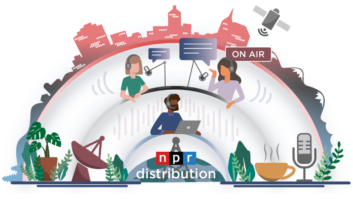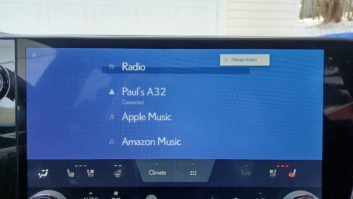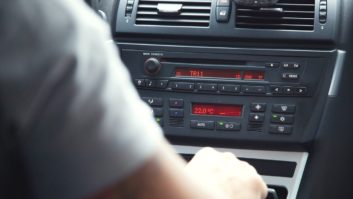ContentDepot System, Coming This Year, Will Transform Public Radio Distribution
WASHINGTON Faced with growing demands for audio distribution, the Public Radio Satellite System plans to deploy a new generation of satellite equipment in late 2004. Known as ContentDepot, the system marks a departure from previous distribution methods in a move to packet-based audio program delivery.
The satellite system now in use delivers audio programs in real time, as analog or AES serial digital audio. Programs are assigned a fixed time to be uplinked to the system, although affiliate stations often will choose to air these programs at various times, using automated recording equipment to capture and play them back.
The change will create a distribution system that treats audio as data files, bringing with it new capabilities, supporters believe. This shift in approach was driven by a need for increased data capabilities and a goal of building the latest generation distribution using non-proprietary hardware, according to Marty Bloss, director of technology for NPR Distribution.
NPR Distribution is the office within NPR responsible for distributing programs to NPR stations and other users of its programs, and thus will be a major user of ContentDepot.
“When we looked at all the requirements for program-associated data and the desire build a system with off-the-shelf components, we quickly realized the need to move to a system that treats everything as data,” Bloss said.
Commercial use?
The new technology has sparked interest on the part of commercial radio networks. Potential applications include the distribution of advertising material and voicetracking to groups of stations. “It’s become pretty obvious to us that others are watching to see how the technology performs,” said Bloss.
PRSS is the distribution network through which programming is delivered to public radio stations. Each participating station is a stakeholder in the collective assets of, and services provided by, the satellite system.
Interconnected stations own their own downlink and uplink equipment. The satellite transponder capacity, as well as the national operating system equipment in Washington, are owned by the Public Radio Satellite Interconnection System Charitable Trust.
PRSS interconnected stations will receive new ContentDepot-compatible equipment. The cost is covered by station interconnect dues. Costs of the new generation of equipment are estimated to be approximately the same as when PRSS converted from analog to digital operations in 1995.
New features will allow the large and diverse population of program producers in public radio to have better control of their programs as well as provide new services to stations such as program-associated data. ContentDepot allows automatic tracking of program carriage and a way to provide promotional materials to stations interested in new programs.
“With ContentDepot, producers can manage their content in ways they haven’t been able to up until now,” stated Laura Jensen, manager of planning and communications for NPR Distribution, which uses PRSS to dispense its programs.
Stations airing programs from ContentDepot will also benefit, the PRSS says. Web-based tools will allow stations to request programs via the Internet and schedule automatic delivery over the satellite.
Programs will be delivered based on the individual station air schedule, eliminating the need to track the current complicated real-time feed schedule. There will still be live streams that air at given times; but everything else will become flexible in download time, within the usage window specified by the program producer. Live news magazines will be fed as data downloads for stations that wish to delay or repeat the playback.
Stations also will be able to create individual profiles that receive messages (such as program rundowns) only for programs of interest, unlike the current internal public radio Direct Access Communications System messaging, known as DACS.
Speed workflow
“We conceive this as a way to make the workflow easier,” said Mike Black, general manager of WEOS(FM) in Geneva, N.Y. At WEOS, existing satellite delivery and automation systems are not connected. Files are moved between these systems via “sneakernet” – copying files manually onto removable media and carrying them from computer to computer.
Black details difficulties in blending programs under the current structure of program delivery.
“I hate promo feeds,” said Black, describing the challenge of manually cutting up a half-hour block of promo feeds that are recorded in real time in order to use these with automation.
ContentDepot addresses this concern by allowing individual stations to request only desired promos, which can be inserted automatically into program automation.
A preview of the ContentDepot system was offered at the Public Radio Engineering Conference in Las Vegas in April. Public radio engineers and managers saw demonstrations of the new distribution and receiver technology.
To open the presentations, the audience was treated to a viewing of a “Satellite Night Fever” video made in 1979 and describing the transition to satellite delivery of NPR programs, an experimental concept at the time.
In what can be seen as a similarly transformational move, the ContentDepot concept employs a multi-channel-per-carrier technology in which many individual audio programs can be uplinked simultaneously. These audio programs are multiplexed into one large data stream of up to 8.5 Megabits per second.
Station receivers decode audio programs as needed from the larger stream. To ensure data integrity, a variety of error detection and correction schemes are used, such as interleaving and Reed-Solomon coding.
Unlike the current distribution system, ContentDepot delivers audio in packets, using a standard known as User Datagram Protocol, similar to how audio files are streamed over the Internet. UDP streaming does not require time synchronization between the uplink and downlink, delivering packets in bursts as satellite channel capacity allows, according to the materials given out by PRSS.
The packets are received and temporarily stored, or buffered, placed into the proper order and finally “streamed” out as real time audio.
Each individual audio or data transmission is assigned a Program ID before being combined into the large data stream. Station receivers then “pull” a desired program transmission by using the PID to reassemble the steam or data file using only the desired packets and ignoring the rest.
An advantage of using a packet-based delivery system is the ability to combine program-associated data with a given audio program, such as associated graphics or promotional material for an individual station Web site. The data is sent as part of the program but is decoded separately and split off using metadata, a set of standard identifiers that allow automated routing, such as importation of information into station Web sites.
Automatic file transfer
Using the high-speed data channel available on the satellite, a program stream can be decoded in real time, similar to the live channels in use with today’s distribution system. For the past year, PRSS has been testing the reliability of this streaming concept and has found it to be as good as the current system, which carries one channel per carrier.
A special Ethernet-connected adapter is used to convert audio data streams for live programs, such as the daily “All Things Considered,” into a real-time audio feed. Each audio adapter is capable of four stereo outputs in both digital and analog formats.
ContentDepot will handle two other types of distribution: live streams that are stored for repeat playback, and audio files that are requested for playback at a certain date and time but that do not require a real-time streaming. An example of the latter would be a pre-produced program like “Car Talk” that may be aired at different times in markets across the United States.
In both cases, the satellite receiver temporarily would store these audio programs as data files on an internal hard drive. PRSS envisions the use of standard File Transfer Protocol to then move audio programs into automation systems owned by the individual stations, via a standard Ethernet connection.
PRSS is working with several manufacturers of broadcast automation systems to make these file transfers automatic.
ContentDepot Operations Workshops are planned in conjunction with public radio meetings through the rest of 2004 to allow station personnel a chance to learn the system before final deployment.







